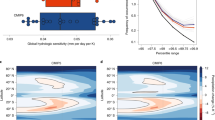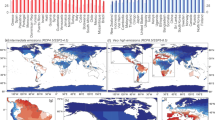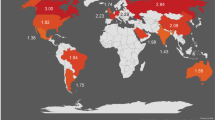Abstract
Global warming is rapidly shifting climate conditions away from what societies and ecosystems are adapted to. While the magnitude of changes in mean and extreme climate are broadly studied, regional rates of change, a key driver of climate risk, have received less attention. Here we show, using large ensembles of climate model simulations, that large parts of the tropics and subtropics, encompassing 70% of current global population, are expected to experience strong (>2 s.d.) joint rates of change in temperature and precipitation extremes combined over the next 20 years, under a high-emissions scenario, dropping to 20% under strong emissions mitigation. This is dominated by temperature extremes, with most of the world experiencing unusual (>1 s.d.) rates relative to the pre-industrial period, but unusual changes also occur for precipitation extremes in northern high latitudes, southern and eastern Asia and equatorial Africa. However, internal variability is high for 20 year trends, meaning that in the near term, trends of the opposite sign are still likely for precipitation extremes, and rare but not impossible for temperature extremes. We also find that rapid clean-up of aerosol emissions, mostly over Asia, leads to accelerated co-located increases in warm extremes and influences the Asian summer monsoons.



Similar content being viewed by others
Data availability
The climate model data used for this analysis are publicly available from the ESGF portals, for example, https://esgf-data.dkrz.de/search/cmip6-dkrz/. ETCCDI indices for CMIP6 models are available from the Copernicus Climate Data Store at https://cds.climate.copernicus.eu/cdsapp#!/dataset/sis-extreme-indices-cmip6?tab=overview (ref. 46), with additional ensemble members calculated for this analysis available from Zenodo (https://doi.org/10.5281/zenodo.12704988) (ref. 47). ERA5 temperature and precipitation data are available from https://cds.climate.copernicus.eu/cdsapp#!/dataset/reanalysis-era5-single-levels?tab=overview (ref. 48). REGEN-LONG is available from https://doi.org/10.25914/5ca4c2c6527d2 (ref. 49) and REGEN-ALL from https://doi.org/10.25914/5ca4c380b0d44 (ref. 50). Population data are available from https://sedac.ciesin.columbia.edu/data/collection/gpw-v4 (refs. 31,45).
Code availability
The code used in this analysis is publicly available from Zenodo (https://zenodo.org/records/12704988) (ref. 47).
References
IPCC: Summary for Policymakers. In Climate Change 2021: The Physical Science Basis (eds Masson-Delmotte, V. et al.) (Cambridge Univ. Press, 2021); https://doi.org/10.1017/9781009157896.001
Gulev, S. K. et al. in Climate Change 2021: The Physical Science Basis (eds Masson-Delmotte, V. et al.) 287–422 (Cambridge Univ. Press, 2021); https://doi.org/10.1017/9781009157896.004
Samset, B. H. et al. Steady global surface warming from 1973 to 2022 but increased warming rate after 1990. Commun. Earth Environ. 4, 400 (2023).
Smith, S. J., Edmonds, J., Hartin, C. A., Mundra, A. & Calvin, K. Near-term acceleration in the rate of temperature change. Nat. Clim. Change 5, 333–336 (2015).
Loarie, S. R. et al. The velocity of climate change. Nature 462, 1052–1055 (2009).
O’Neill, B. C. & Oppenheimer, M. Climate change impacts are sensitive to the concentration stabilization path. Proc. Natl Acad. Sci. USA 101, 16411–16416 (2004).
Fischer, E. M., Sippel, S. & Knutti, R. Increasing probability of record-shattering climate extremes. Nat. Clim. Change 11, 689–695 (2021).
Philip, S. Y. et al. Rapid attribution analysis of the extraordinary heat wave on the Pacific coast of the US and Canada in June 2021. Earth Syst. Dyn. 13, 1689–1713 (2022).
Ranasinghe, R. et al. in Climate Change 2021: The Physical Science Basis (eds Masson-Delmotte, V. et al.) 1767–1926 (Cambridge Univ. Press, 2021); https://doi.org/10.1017/9781009157896.014
Zscheischler, J. et al. Future climate risk from compound events. Nat. Clim. Change 8, 469–477 (2018).
Seneviratne, S. I. et al. in Climate Change 2021: The Physical Science Basis (eds Masson-Delmotte, V. et al.) 1513–1766 (Cambridge Univ. Press, 2021); https://doi.org/10.1017/9781009157896.013
IPCC Climate Change 2021: The Physical Science Basis (eds Masson-Delmotte, V. et al.) (Cambridge Univ. Press, 2021); https://doi.org/10.1017/9781009157896
Sedláček, J. & Knutti, R. Half of the world’s population experience robust changes in the water cycle for a 2 °C warmer world. Environ. Res. Lett. 9, 044008 (2014).
Lehner, F. & Stocker, T. F. From local perception to global perspective. Nat. Clim. Change 5, 731–734 (2015).
Chavaillaz, Y., Joussaume, S., Dehecq, A., Braconnot, P. & Vautard, R. Investigating the pace of temperature change and its implications over the twenty-first century. Climatic Change 137, 187–200 (2016).
Iturbide, M. et al. An update of IPCC climate reference regions for subcontinental analysis of climate model data: definition and aggregated datasets. Earth Syst. Sci. Data 12, 2959–2970 (2020).
Sanderson, B. M., Oleson, K. W., Strand, W. G., Lehner, F. & O’Neill, B. C. A new ensemble of GCM simulations to assess avoided impacts in a climate mitigation scenario. Climatic Change 146, 303–318 (2018).
Hawkins, E. & Sutton, R. Time of emergence of climate signals. Geophys. Res. Lett. 39, L01702 (2012).
King, A. D. et al. The timing of anthropogenic emergence in simulated climate extremes. Environ. Res. Lett. 10, 094015 (2015).
Diffenbaugh, N. S. & Scherer, M. Observational and model evidence of global emergence of permanent, unprecedented heat in the 20th and 21st centuries. Climatic Change 107, 615–624 (2011).
Chen, D. et al. in Climate Change 2021: The Physical Science Basis (eds Masson-Delmotte, V. et al.) 147–286 (Cambridge Univ. Press, 2021); https://doi.org/10.1017/9781009157896.003
Mahlstein, I., Knutti, R., Solomon, S. & Portmann, R. W. Early onset of significant local warming in low latitude countries. Environ. Res. Lett. 6, 034009 (2011).
Nguyen, T.-H., Min, S.-K., Paik, S. & Lee, D. Time of emergence in regional precipitation changes: an updated assessment using the CMIP5 multi-model ensemble. Clim. Dyn. 51, 3179–3193 (2018).
Mahlstein, I., Portmann, R. W., Daniel, J. S., Solomon, S. & Knutti, R. Perceptible changes in regional precipitation in a future climate. Geophys. Res. Lett. 39, L05701 (2012).
United Nations Framework Convention on Climate Change Paris Agreement (United Nations, 2015); https://unfccc.int/sites/default/files/resource/parisagreement_publication.pdf
Wilcox, L. J. et al. Accelerated increases in global and Asian summer monsoon precipitation from future aerosol reductions. Atmos. Chem. Phys. 20, 11955–11977 (2020).
Hawkins, E. & Sutton, R. The potential to narrow uncertainty in projections of regional precipitation change. Clim. Dyn. 37, 407–418 (2011).
Lehner, F. et al. Partitioning climate projection uncertainty with multiple large ensembles and CMIP5/6. Earth Syst. Dyn. 11, 491–508 (2020).
Persad, G. et al. Rapidly evolving aerosol emissions are a dangerous omission from near-term climate risk assessments. Environ. Res. Clim. 2, 032001 (2023).
Schumacher, D. L. et al. Exacerbated summer European warming not captured by climate models neglecting long-term aerosol changes. Commun. Earth Environ. 5, 182 (2024).
Gridded Population of the World, Version 4 (GPWv4): Population Density Adjusted to Match 2015 Revision UN WPP Country Totals, Revision 11 (CIESIN, 2018); https://doi.org/10.7927/H4F47M65
Eyring, V. et al. Overview of the Coupled Model Intercomparison Project Phase 6 (CMIP6) experimental design and organization. Geosci. Model Dev. 9, 1937–1958 (2016).
Mackallah, C. et al. ACCESS datasets for CMIP6: methodology and idealised experiments. J. South. Hemisph. Earth Syst. Sci. 72, 93–116 (2022).
Mauritsen, T. et al. Developments in the MPI-M Earth System Model version 1.2 (MPI-ESM1.2) and its response to increasing CO2. J. Adv. Model. Earth Syst. 11, 998–1038 (2019).
Swart, N. C. et al. CCCma CanESM5 Model Output Prepared for CMIP6 CMIP Historical (Earth System Grid Federation, 2019); https://doi.org/10.22033/ESGF/CMIP6.3610
Döscher, R. et al. The EC-Earth3 Earth system model for the Coupled Model Intercomparison Project 6. Geosci. Model Dev. 15, 2973–3020 (2022).
Wyser, K. et al. The SMHI Large Ensemble (SMHI-LENS) with EC-Earth3.3.1. Geosci. Model Dev. 14, 4781–4796 (2021).
Meehl, G. A. et al. Context for interpreting equilibrium climate sensitivity and transient climate response from the CMIP6 Earth system models. Sci. Adv. 6, eaba1981 (2022).
O’Neill, B. C. et al. The Scenario Model Intercomparison Project (ScenarioMIP) for CMIP6. Geosci. Model Dev. 9, 3461–3482 (2016).
Sillmann, J., Kharin, V. V., Zhang, X., Zwiers, F. W. & Bronaugh, D. Climate extremes indices in the CMIP5 multimodel ensemble: part 1. Model evaluation in the present climate. J. Geophys. Res. Atmos. 118, 1716–1733 (2013).
Hersbach, H. et al. The ERA5 global reanalysis. Q. J. R. Meteorol. Soc. 146, 1999–2049 (2020).
Contractor, S. et al. Rainfall Estimates on a Gridded Network (REGEN)—a global land-based gridded dataset of daily precipitation from 1950 to 2016. Hydrol. Earth Syst. Sci. 24, 919–943 (2020).
Ziese, M. et al. GPCC Full Data Daily Version.2018 at 1.0°: Daily Land-Surface Precipitation from Rain-Gauges built on GTS-based and Historic Data (GPCC, 2018); https://doi.org/10.5676/DWD_GPCC/FD_D_V2018_100
Menne, M. J., Durre, I., Vose, R. S., Gleason, B. E. & Houston, T. G. An overview of the global historical climatology network-daily database. J. Atmos. Ocean. Technol. 29, 897–910 (2012).
Gridded Population of the World, Version 4 (GPWv4): Population Count Adjusted to Match 2015 Revision of UN WPP Country Totals, Revision 11 (CIESIN, 2018); https://doi.org/10.7927/H4PN93PB
Sandstad, M., Schwingshackl, C. & Iles, C. Climate Extreme Indices and Heat Stress Indicators Derived from CMIP6 Global Climate Projections (C3S CDS, 2022); 1https://doi.org/10.24381/cds.776e08bd
Iles, C. E. Data and code archival for Iles et al. 2024, Nature Geoscience, ‘Strong regional trends in extreme weather over next two decades under high and low emission pathways’. Zenodo https://doi.org/10.5281/zenodo.12704988 (2024).
Hersbach, H. et al. ERA5 Hourly Data on Single Levels from 1940 to Present (C3S CDS, 2023); https://doi.org/10.24381/cds.adbb2d47
Contractor, S. Rainfall Estimates on a Gridded Network (REGEN) Based on Long-Term Station Data v.1–2019 (NCI Australia, 2019); https://doi.org/10.25914/5ca4c2c6527d2
Contractor, S. Rainfall Estimates on a Gridded Network (REGEN) Based on All Station Data v.1–2019 (NCI Australia, 2019); https://doi.org/10.25914/5ca4c380b0d44
Kim, Y.-H., Min, S.-K., Zhang, X., Sillmann, J. & Sandstad, M. Evaluation of the CMIP6 multi-model ensemble for climate extreme indices. Weather Clim. Extrem. 29, 100269 (2020).
Acknowledgements
This research has received funding from the European Union’s Horizon 2020 research and innovation programme under grant agreements no. 101003826 through the CRiceS project (C.E.I., B.H.S., M.T.L., M.S.) and no. 820655 through the EXHAUSTION project (M.S.) and from the Norwegian Research Council through the projects CATHY (324182; C.E.I., B.H.S., M.T.L., N.S., L.J.W.) and QUISARC (248834; C.E.I., B.H.S., M.T.L.). We acknowledge the Centre for Advanced Study in Oslo, Norway, which funded and hosted our HETCLIF centre during the academic year of 2023/2024. We acknowledge the World Climate Research Programme, which, through its Working Group on Coupled Modelling, coordinated and promoted CMIP6. We thank the climate modelling groups for producing and making available their model output, the Earth System Grid Federation (ESGF) for archiving the data and providing access, and the multiple funding agencies who support CMIP6 and ESGF. We also acknowledge the ETCCDI indices for CMIP6 provided through the Copernicus Climate Data Store, documented in refs. 40,51.
Author information
Authors and Affiliations
Contributions
C.E.I. and B.H.S. conceived and designed the experiments. C.E.I. performed the experiments and analysed the data. M.S. contributed materials/analysis tools. C.E.I., B.H.S., M.S., N.S., L.J.W. and M.T.L. wrote the paper.
Corresponding author
Ethics declarations
Competing interests
The authors declare no competing interests.
Peer review
Peer review information
Nature Geoscience thanks Vikki Thompson and the other, anonymous, reviewer(s) for their contribution to the peer review of this work. Primary Handling Editor: Tom Richardson, in collaboration with the Nature Geoscience team.
Additional information
Publisher’s note Springer Nature remains neutral with regard to jurisdictional claims in published maps and institutional affiliations.
Supplementary information
Supplementary Information
Supplementary Figs. 1–26, Table 1 and text on rates of change in subsequent periods, effects of aerosol clean-up on near-term rates of change, model evaluation and results for CDD.
Rights and permissions
Springer Nature or its licensor (e.g. a society or other partner) holds exclusive rights to this article under a publishing agreement with the author(s) or other rightsholder(s); author self-archiving of the accepted manuscript version of this article is solely governed by the terms of such publishing agreement and applicable law.
About this article
Cite this article
Iles, C.E., Samset, B.H., Sandstad, M. et al. Strong regional trends in extreme weather over the next two decades under high- and low-emissions pathways. Nat. Geosci. 17, 845–850 (2024). https://doi.org/10.1038/s41561-024-01511-4
Received:
Accepted:
Published:
Issue Date:
DOI: https://doi.org/10.1038/s41561-024-01511-4
- Springer Nature Limited





